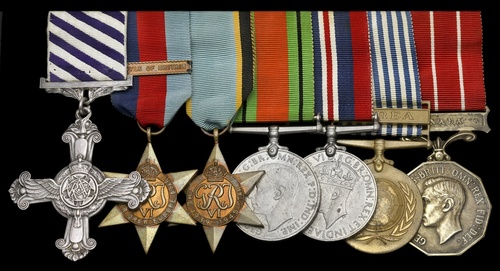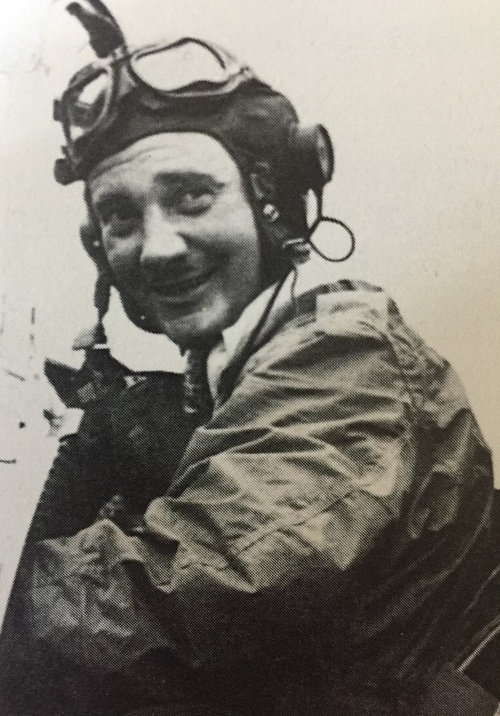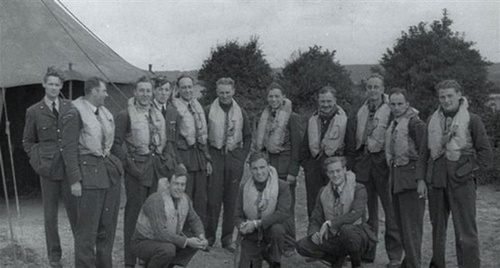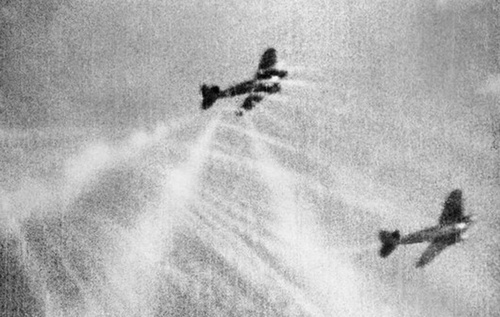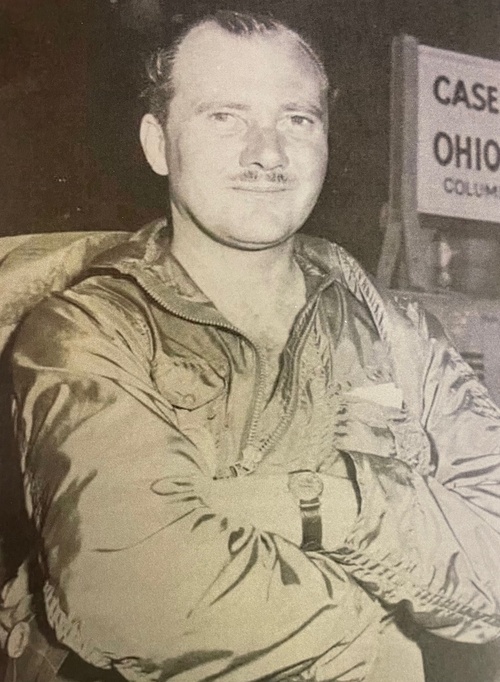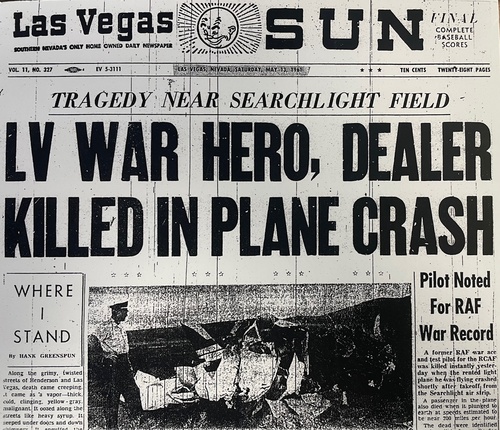Auction: 25001 - Orders, Decorations and Medals
Lot: 384
(x) 'The C.O., Michael, and John had each destroyed an Me. 110, while Mac [McArthur] shot down two Junkers 87 dive-bombers. He would have got an Me. 110 also and got his sights on it, but nothing happened when he pressed his trigger. His ammunition was finished. So a very lucky Me. 110 lived to fight another day. Mac was very pleased about this fight, and certainly a bag of two for one's first action is very good. But it made him rather over-confident, and for the next few days he regarded the German Air Force rather as an organization which provided him with a little target practice and general harmless amusement. He soon learnt better!'
One of numerous references to J. H. G. 'Butch' McArthur in David Crooks's wartime account of No. 609 Squadron in the Battle of Britain; Spitfire Pilot, refers.
The outstanding Battle of Britain ace's immediate D.F.C. group of seven awarded to Wing Commander J. H. G. 'Butch' McArthur, Royal Canadian Air Force, late Royal Air Force
A superb airman, who had honed his flying skills in the Experimental Section of the Royal Aircraft Establishment in the lead up to hostilities, he claimed 8 confirmed 'kills' and 3 'probables' as a Flight Commander in Spitfires of No. 609 (West Riding) Squadron at the height of the Battle, on one occasion closing the range to just 10-20 yards
His numerous combats, and those of his fellow pilots in 609 Squadron, are vividly recounted in the pages Flight Lieutenant D. M. Crook's famous wartime publication Spitfire Pilot
Post-war, and having served in the Royal Canadian Air Force at the time of the Korean conflict, his remarkable flying career ended in tragedy during a pleasure flight over Las Vegas in May 1961: both he and his passenger - a croupier from the famous Horseshoe Club - were killed when their aircraft inexplicably dived into the ground
Distinguished Flying Cross, G.VI.R., the reverse officially dated '1940'; 1939-45 Star, clasp, Battle of Britain; Air Crew Europe Star; Defence and War Medals 1939-45; U.N. Korea 1950-54 (30386 McArthur J. H. G.), officially inscribed Canadian issue; Canadian Forces Decoration, G.VI.R., 2nd issue, the reverse of the suspension bar officially inscribed 'F/L J. H. G. McArthur', mounted as worn, good very fine (7)
Provenance:
Sotheby's, 6 March 1986 (Lot 628), when sold by the recipient's sister.
D.F.C. London Gazette 22 October 1940:
'This officer has led his flight and squadron with skill and determination. His brilliant leadership has been reflected in the high standard of morale in the flight. He has destroyed at least seven aircraft.'
The original recommendation, for an immediate award which was approved by Dowding, states:
'This officer has been a great asset to the Squadron since he joined it on 1 August 1940. His flying has been of the highest standard and he always leads his flight with skill and determination. On the occasions that he has led the Squadron he has displayed a sound sense of leadership and initiative. Individually he has always been keen and energetic in his desire to engage the enemy.
To date he has destroyed 7 (confirmed) and 2 (unconfirmed) enemy aircraft and has severely damaged 2 others.'
Covering remarks:
'An outstanding fighter pilot who has now destroyed 8 enemy aircraft (confirmed) and 3 others probably, besides damaging a further 2.
His brilliant and inspiring leadership has raised the morale of his flight to a very high standard since he took it over.'
James Henry Gordon McArthur - or "Butch" to his friends and comrades - was born in Tynemouth on 12 February 1913 and was educated at West Jesmond Council School and Rutherford College, prior to attending the Marine School in South Shields. He subsequently found employment with the Marconi Company as a seagoing Radio Officer, in addition to obtaining certificates for Aircraft Radio Operation and Navigation.
The latter qualifications led to his participation in the England to Australia 'MacRobertson Air Race' in 1934, when he flew with Captain Neville Stack, A.F.C., as his Radio-Navigator but their attempt ended in Athens - under controversial circumstances.
On his return home, McArthur qualified for his Aero Certificate (No. 12614) at Redhill Aero Club in March 1935 and then teamed up with Captain T. Campbell-Black for an attempt on the London to Cape Town return record. Having flown non-stop from Hatfield to Cairo in their De Havilland Comet G-ADEF 'Boomerang', they took off for another refuelling stop in Kenya but, due to a problem with the aircraft, they were compelled to bale out north of Khartoum. Both landed safely in the desert and, on being rescued, gained membership of the famous Caterpillar Club, McArthur then being the youngest member.
Brief employment as a First Officer in British Continental Airways having followed, McArthur was granted a short service commission in the Royal Air Force in May 1936. Confirmed in the rank of Pilot Officer after attending a course at R.A.F. Thornaby, he was posted to the Station Flight at Aldergrove and thence, in May 1938 to the Experimental Section at the Royal Aircraft Establishment at Farnborough as a Flying Officer and test pilot.
McArthur was likewise employed on the outbreak of hostilities in September 1939 and, on being advanced to Flight Lieutenant, attended a refresher course at No. 7 O.T.U., Hawarden in July 1940. A subsequent posting to No. 238 Squadron was short-lived, however, for he was called back to Farnborough. But he continued to press for an operational posting.
Battle of Britain
That wish was granted on 1 August 1940, when McArthur joined No. 609 (West Riding) Squadron, an Auxiliary Air Force unit, as a Flight Commander at Middle Wallop. Commanded by Squadron Leader H. S. Darley, D.S.O., 609 was largely manned by a pre-war class of weekend gentlemen fliers, among them Noel "Aggy" Agazarian and John Dundas; the latter's brother, Hugh, flew as wingman to Douglas Bader throughout the Battle.
Over the coming weeks, on being 'scrambled' out of Middle Wallop and the satellite airfield at Warmwell, McArthur's 'brilliant leadership' of his flight - and on occasion the squadron - undoubtedly left its mark on such men. In writing to his mother in October 1940, John Dundas reported with pride that 609 was finally gaining recognition, listing McArthur's award of the D.F.C. as a case in point. He also noted that he had been given command of 'B' Flight, owing to McArthur being in hospital. More on that, later.
Meanwhile, McArthur opened his operational account on 8 August 1940, when he destroyed a brace of Ju. 87s in a dogfight over the Isle of Wight-Weymouth sector. His combat report takes up the story:
'…I dived on the outside of the Ju. 87 from just over 5,000 feet, fired a 7 second burst and saw him turn on his back and go into the sea. The formation then split up and I regained 4,000 feet very quickly. Height of Ju. was about 100 feet. I then dived again and gave a long burst of 10 seconds on another Ju. 87 which started to emit black smoke and dive into the sea. I then found the Me. 110. I climbed up a bit and was coming in at him from the port side and slightly above him. I turned quickly away from him and after a turn or two found myself quickly on his tail. I then found I had no more ammunition so pulled the override and hurried home … '
In Spitfire Pilot, David Crook recalls the squadron's 'bag' thus:
'The C.O., Michael, and John had each destroyed an Me. 110, while Mac [McArthur] shot down two Junkers 87 dive-bombers. He would have got an Me. 110 also and got his sights on it, but nothing happened when he pressed his trigger. His ammunition was finished. So a very lucky Me. 110 lived to fight another day.
Mac was very pleased about this fight, and certainly a bag of two for one's first action is very good. But it made him rather over-confident, and for the next few days he regarded the German Air Force rather as an organization which provided him with a little target practice and general harmless amusement. He soon learnt better!
That evening, when we again patrolled the convoy, he led Michael and me almost over Cherbourg in search of enemy fighters and frightened us considerably! Finally I called him up on the R.T., and politely pointed out that we were now fifty miles out to sea and that the French coast was looming up ahead. So he turned back with great reluctance!'
Just three days later in a combat over Swanage on the 11th, McArthur had a convincing scrap with another Me. 110:
'…At just over 27,000 feet, I decided to cut across the lower 110s. I fired a short burst of 5 seconds at one, and saw his glass roof come off and he turned over and dived. I could not follow him down, as other 110s were all around me, and while doing violent evasive action, I spun down for about 15,000 feet, and then had trouble getting my motor to start again. Estimate number of machines at around 100. Saw many machines falling down in flames and two parachutists, could distinguish nothing as was feeling unwell at the time…'
David Crook recalled that McArthur 'came back feeling rather shaken':
'…he had been attacked by two Me.s and in his efforts to get away, his Spitfire got into a spin and he came down to about 5,000 feet before he could recover. From now onwards he was a very wise and successful Flight Commander, and never went looking for unnecessary trouble!'
Duly credited with his first Me. 110, he claimed another as probably destroyed off Portsmouth the very next day, while on the 13th he damaged a Me. 109. Of events on the 12th, when he was leading Green Section over the Portsmouth area, his combat report states:
'…I then dived and got a good deflection shot on one of the Me. 110s which was slightly straggling. I gave him a 5-10 second burst and saw most of the tracer go into his wings and then dived away. Used half my ammunition.'
David Crook recalled that the 12th was 'a boiling summer's day and we all got back absolutely soaked in sweat, even though we were flying in shirt sleeves.' He further recalled how they journeyed into London for drinks and dinner at the Trocadero:
'It seemed so funny to be dining peacefully in Piccadilly only a few hours after being in such a desperate fight.'
In a combat over Southampton on the 15th, McArthur closed - and destroyed - another Me. 110 from a range of just 10-20 yards:
'…I turned quickly and out came the Me. 110. He didn't seem to be able to turn very quickly. When 3,000 feet above it and on its port side I attacked and opened fire at about 200-300 yards … and by this time almost dead astern … both engines were on fire and a fair piece of something fell off. I kept firing until about 10-20 yards from his tail when he turned violently to port and over on his back. I followed him down for about 7,000 feet … and saw him dive into the ground … '
And by way of closing his operational account for the month of August, he took out yet another Me. 109 on the 24th when he closed the range to 100 yards - it went into a vertical dive and crashed on the ground between Warmwell and Poole. The original Combat Report for that event accompanies the Lot. In total, therefore, 609 had claimed nearly 50 confirmed 'kills' by the month's end, but such success came at a terrible price: most of the unit's pre-war auxiliary pilots were now dead or missing.
A sense of that loss is to be found in the words of John Dundas, in a letter sent to his brother Hugh on 25 August:
'The 109s nearly made hay with us over the Isle of Wight yesterday. They sent us off too late to do anything about the bombing of Portsmouth and too low to do anything about the myriads of 109s who were hovering around the scene and who, when they saw poor 609 painfully clambering into the sun, came down on us. The result was that one of our machines was shot to hell, two more damaged and not one of us succeeded in firing a round. I was reduced to the last resort of a harassed pilot - spinning. It was humiliating … '
September was no less frantic and McArthur's gallant and inspiring leadership was now at a premium. He didn't disappoint, destroying a Do. 215 on the 7th and damaging another on the 15th, a landmark date that became known as Battle of Britain Day. McArthur takes up the story:
'…When patrolling Brooklands-Windsor at angels 15, we sighted enemy composed of about 25-30 Do. 215s, about angels 17 over London, supported by Me. 110s and 109s stepped up behind. I was leading and climbed up with 'B' Flight in line astern to angels 20, and turned into attack the Dorniers from ahead of beam. I overshot a bit and finished up dead ahead of the bombers … encountered very heavy forward fire from the bomber formation. Owing to my overshooting, I could not get my sights on in this attack, so dived under the bombers and then climbed up alongside the port side of their formation and fired two bursts of about 5-6 seconds, opening at approximately 450 yards and finishing at about 100 yards. The Do. 215 broke away from the formation but I could not follow it any more, as it became necessary to take violent evasive action to get out of the way of about five Me. 109s which came just behind the bombers … '
In another patrol in the afternoon of the 15th, McArthur's Blue Section engaged 40 Me. 110s and 12 Ju.87s over Warmwell, but he lost consciousness after his oxygen supply failed at 25,000 feet; coming round as his Spitfire hurtled earthwards in a high-speed dive, he just managed to regain control and avert disaster. But the speed of his breakneck descent from such a high altitude damaged his ear drums.
Nonetheless, he was back in action on the 25th, when he intercepted the returning aircraft of a Luftwaffe raid on the Bristol Aeroplane Company's works at Filton. In the ensuing combat around midday in the Bournemouth area, he downed yet another Me. 110 and engaged a He. 111, the latter attack being captured on his Spitfire's gun camera.
This, however, proved to be his final operational sortie, for with ongoing issues with his damaged ear drums, he was hospitalised and taken off operations. David Crooks recalled that he was 'very sad about it':
'So were we all - he had been a grand chap and an excellent Flight Commander, besides being very successful individually. I am glad to say that he got the D.F.C. a few days later, which bucked him up a lot.'
He also sat for a portrait by Cuthbert Orde.
Advanced to the temporary ranks of Squadron Leader in September 1941 and Wing Commander in January 1944, McArthur undertook experimental work in Canada and the U.S.A. in 1942-45, including early test flights on B. 17 aircraft.
Royal Canadian Air Force
Released from the R.A.F. as a substantive Squadron Leader in 1947, McArthur joined the R.C.A.F. at Edmonton, Alberta in the following year, and was posted to the Winter Experimental Establishment.
It was about this time that he was granted leave to undertake air racing, having in August 1949 purchased - in partnership with Flight Lieutenant Ken Brown, D.F.C., of 'Dambusters' fame - a Spitfire Mk. XIV for $1250. With sponsorship from Imperial Oil, he duly entered the Tinnerman Air Races in Cleveland, Ohio and achieved third place in the Thompson Trophy in September 1949. Following the event, he stole the Spit and a leather holdall belonging to Brown, fled the scene and sold the aircraft for cash.
His 'racing leave' expired, McArthur was posted to the Military Air Transport Service at Tacoma, Washington, in which capacity he served for 10 months in support of the Korea operations, ferrying American troops to, and casualties from, Tokyo. He was awarded the U.N. Korea Medal (not entitled to the Queen's Korea medal) and the Canadian Forces Decoration.
In 1952, he became associated with the radar chain of the R.C.A.F. Air Defence System, employment that led to his involvement with B. 25 and B. 29 aircraft of the Electronic Counter Measures Squadron, U.S.A.F. But in 1957, following serious injuries received in a motor accident, he was honourably retired as a Wing Commander.
Life thereafter was far from happy, McArthur going through a divorce and suffering from monetary troubles. He is said to have settled in Mexico at one point. Tragically, he was killed in a civilian flying accident in May 1961. He had rented an aircraft at Searchlight Airport, south of Las Vegas, to take Raymond Horton, a croupier at the Horseshoe Club, for a pleasure flight. The aircraft circled the area with the occupants waving to friends, before it inexplicably dived into the ground. No cause was ever found. Butch was buried at Woodlawn Cemetery, Las Vegas, with full military honours arranged by the Vancouver Legion; sold together with the Combat Report for 24 August, a selection of career photographs (8), including McArthur in the cockpit of his 'racing Spitfire', together with a copy of Crook's Spitfire Pilot and a file of copied research.
Subject to 5% tax on Hammer Price in addition to 20% VAT on Buyer’s Premium.
Estimate
£25,000 to £30,000
Starting price
£22000

